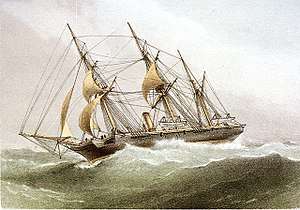HMS Wild Swan (1876)
HMS Wild Swan was an Osprey-class sloop built for the Royal Navy in the mid-1870s. She was launched in 1877 and became a base ship in 1904, being renamed Clyde. She was renamed Columbine in 1913 and was sold for breaking in 1920.
 | |
| History | |
|---|---|
| Name: | HMS Wild Swan |
| Namesake: | Swan |
| Builder: | Robert Napier and Sons, Govan, Glasgow |
| Cost: | Hull £39,643, machinery £11,853 |
| Laid down: | 14 September 1874 |
| Launched: | 28 January 1876 |
| Completed: | 23 August 1876 |
| Decommissioned: | Hulked, 1 May 1904 |
| Renamed: | HMS Clyde, 1 May 1904; HMS Columbine, July 1913 |
| Fate: | Sold for scrap, 4 May 1920 |
| General characteristics | |
| Class and type: | Osprey-class screw composite sloop |
| Displacement: | 1,130 long tons (1,150 t) |
| Length: | 170 ft (51.8 m) (p/p) |
| Beam: | 36 ft (11.0 m) |
| Draught: | 15 ft 9 in (4.8 m) |
| Depth: | 19 ft 6 in (5.9 m) |
| Installed power: |
|
| Propulsion: |
|
| Sail plan: | Barque rig |
| Speed: | 10 knots (19 km/h; 12 mph) |
| Range: | 1,120 nmi (2,070 km; 1,290 mi) at 10 knots (19 km/h; 12 mph) |
| Complement: | 140 |
| Armament: |
|
Design and construction
Wild Swan was an Osprey-class sloop-of-war, with a composite hull design.[1] The ship had a displacement of 1,130 tons, was 170 feet (52 m) long, had a beam of 36 feet (11 m), and a draught of 15 feet 9 inches (4.80 m).[2][1] An R & W Hawthorn two-cylinder horizontal returning-rod steam engine fed by three cylindrical boilers provided 797 indicated horsepower to the single 13 ft (4.0 m) propeller screw.[1] This gave Wild Swan a top speed of 10.3 knots (19.1 km/h; 11.9 mph), which failed to meet the required contract speed. After the first commission the engine was replaced by a Devonport Dockyard two-cylinder horizontal compound-expansion steam engine. She had a maximum range of 1,480 nautical miles (2,740 km; 1,700 mi) at 10 kn (19 km/h; 12 mph).[1] In addition to the steam-driven propeller, the vessel was also barque rigged.[1] The standard ship's company was between 140 and 150.[1]
Armament consisted of two 7-inch (90cwt) muzzle-loading rifled guns, four 64-pound guns, four machine guns, and one light gun.[1] Wild Swan and her sister-ship Pelican were re-armed later with two 6-inch (81cwt) BL guns and six 5-inch (35cwt) BL guns.[1]
Wild Swan was built by Robert Napier and Sons, of Govan, Scotland. The vessel was laid down on 14 September 1874 as yard number 341.[1] She was launched on 28 January 1876, and commissioned into the Royal Navy on 23 August 1876.[1] Construction costs included £39,643 for the hull, and £11,853 for machinery and equipment.[1]
Service history
Wild Swan patrolled off the coast of Mozambique in 1880, operating against the slave trade.[3] In early 1881, she operated together with Portuguese forces against slavers, landing a Portuguese force at Conducia Bay on 12 February 1881 and supporting them with gun and rocket fire.[4]
Wild Swan was decommissioned and placed on the list of Admiralty vessels for sale in 1900. She was withdrawn from the list and re-fitted in late 1901 as a training ship in Kingstown Harbour for men of the Royal Navy Reserve and coastguards of the North of Ireland stations.[5] She also served as tender to HMS Melampus, coast guard ship at Kingstown.[6]
Fate
Wild Swan became a base ship on 1 May 1904 and was renamed Clyde. She was renamed again in July 1913, becoming Columbine. She was sold for breaking to the Forth Shipbreaking company on 4 May 1920.[1]
Notes
- The horizontal returning-rod steam engine by R & W Hawthorn failed to meet the contract speed and was replaced after the first commission by a Devonport Dockyard 2-cylinder horizontal compound-expansion steam engine[1]
References
- Winfield, pp.291-292
- "Naval Sloops at battleships-cruisers.co.uk". Retrieved 30 August 2008.
- "A Wild Dash Among Sharks". The Bathurst Post. 15 October 1894. p. 6.
- Clowes 1903, p. 314.
- "Naval & military intelligence". The Times (36562). London. 17 September 1901. p. 9.
- "Naval & Military intelligence". The Times (36642). London. 19 December 1901. p. 7.
- Ballard, G. A. (1939). "British Sloops of 1875: The Larger Ram-Bowed Type". Mariner's Mirror. Cambridge, UK: Society for Nautical Research. 25 (January): 35–49.
- Chesneau, Roger; Kolesnik, Eugene M., eds. (1979). Conway's All the World's Fighting Ships 1860-1905. Greenwich, UK: Conway Maritime Press. ISBN 0-8317-0302-4.
- Clowes, William Laird (1903). The Royal Navy: A History From the Earliest Times to the Death of Queen Victoria: Volume VII. Sampson Low, Marston and Company.
- Winfield, R.; Lyon, D. (2004). The Sail and Steam Navy List: All the Ships of the Royal Navy 1815–1889. London: Chatham Publishing. ISBN 978-1-86176-032-6.